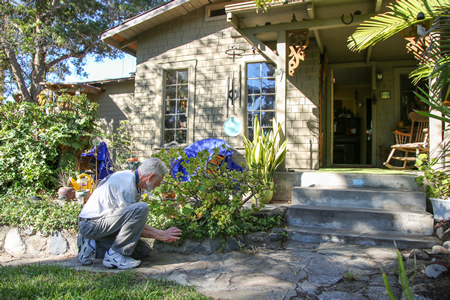Emily Sparkuhl’s 440 Aster St. home is a charming 1919 bungalow that sits on the city’s Historic Inventory List.

Sparkuhl, who splits time living in San Francisco and Laguna Beach, currently rents the property to her brother, Jason Wineinger. “We both grew up there,” said Sparkuhl. The property bought by their grandfather in 1952 still has the same structure as when it was built in 1919, but has undergone additions over time. “There are no halls in the home and it has two front doors,” Wineinger said.
“I want to keep it as is,” said Sparkuhl, who didn’t know her property was one of several highlighted at the second of the city’s Heritage Committee workshops on updating the historic preservation ordinance and the city’s inventory of historic properties.
Sparkuhl’s property provides an example of possible alterations to the criteria intended to preserve historic property. Currently, the statute calls for a property to be at least 50 years old before it could be placed on the city’s Historic Register, the city’s official roster of historic homes. In addition, consideration can be given to appearance and integrity of a structure with an “E,” “K” and “C” rating system. “E” is defined as “exceptional buildings with outstanding historic integrity; “K” for key buildings with very good historic integrity; and “C” contributive buildings that contribute to overall character and history of a neighborhood, but may not be unique in and of themselves.”
Aster is a “C” rated structure. Thus, Sparkuhl would not currently be allowed to receive any of the incentives designated for historic properties.
Recently, though, Jan Ostashay, a city hired expert consultant on historic properties, recommended that 440 Aster be moved out of the “C” designation. According to city senior planner Martina Caron, “Jan classified the property on Aster Street with a ‘K’ rating because she finds that it merits historic consideration. Anything that merits historic consideration is pursuant to a California Environmental Quality Act (CEQA) review. If the proposed rating is adopted, then it could be put on the register and it could receive incentives,” she said.
Under the current ordinance, only properties on the city’s Historic Registry are eligible for incentives. The city maintains a separate Historic Inventory, the city’s schedule of potential historic properties, which are ineligible for many benefits. Specifically, the Aster re-designation would allow the owner to become eligible for Mills Act property tax credits, which can substantially reduce property taxes in exchange for the owner’s commitment to preserve the historical integrity of the property. Currently Mills Act tax savings are only available to historic registry properties graded “E” or “K” but not “C” rated structures.
Laguna, settled in the 1870s, was incorporated in 1927. There are 291 homes currently on the city’s Historic Registry List, according to the city clerk’s office. The Historic Inventory, which has been re-surveyed for the first time in several decades, consists of 550 homes, Caron said. “Together, the two lists constitute between 6-7 percent of the town’s housing stock,” she said.
Committee members and a few residents on Nov. 16 listened to a presentation on ratings by city staff, led off first by a return to questions about incentives, which emerged from an earlier workshop in October. “I am in favor of every one of the incentives on this list,” said committee member Michael Boone, referring to 18 potential lures offering financial, development and red-tape smoothing benefits for property owners that embrace a historic designation. “We need special privileges to create a desirability for owners to want to own a historic structure,” he said.
The incentive dialogue provided a smooth transition to the topic under discussion. Community Development Director Greg Pfost noted that, “any incentives will be based on the property’s historic rating.”
The ensuing two-hour discussion provided a window into an esoteric system of designations and specifications, which govern the registry process from the federal, state and local level. In looking at recommending changes to the existing historic ordinance, the committee grappled with philosophical as well as pragmatic concerns including how a structure is determined to be historic and at what age should a structure garner consideration as historic.
Aster Street’s reclassification from “C” to “K” status was one method of adapting the historic standards for property designation. The committee also was presented with a new idea on how to deal with “C” properties, which the committee deems historically important, but would not be eligible under new CEQA rules that do not classify these structures as meeting the state standards.
A proposed Structure of Merit designation would provide a method for “C” structures to be eligible for incentives. “The Structure of Merit was originally proposed as an option to provide incentives to structures that are not considered historic by CEQA,” said Caron.
Further, the existing ordinance cites other guidelines for registry status including: “Structures that most represent character, interest or value as part of the heritage of the city; the location as a site of significant historic event; the identification with a person or persons or groups who significantly contributed to the culture and development of the city; the exemplification of a particular architectural style or way of life important to the city; and embodiment of elements of outstanding attention to architectural design, detail, materials or craftsmanship.”
Committee members were then presented with an array of possible new criteria judgments to ensure that structures that may currently not be recognized as historic can be added to the Historic Inventory. New possibilities, among others, included re-identifying the appropriate age of a structure, perhaps altering the 50 year benchmark; highlighting the work of a notable, builder or architect; a selection based on the structure’s location or visual familiarity to residents; and preserving rare and diminishing examples of important architectural structures.
“These are complex changes,” said committee member Carl Iverson. “If the city wants to invest in these properties, then the city needs to put up some dollars,” he said, referring to extending financial incentives or reductions in development costs to more owners of historic properties.
Committee member Anne Frank cited the importance of clarifying the ranking process for residents. “People do not know what their property is rated as,” she said. “This could be solved very easily at the beginning of the process.”
A third workshop slated for January would again re-address the findings of the ratings discussion, while also tackling opt-out provisions for residents not desiring placement on the Historic Inventory list.





[…] Century Old Town Wrestles to Define What's Historic … contributed to the culture and development of the city; the exemplification of a particular architectural style or way of life important to the city; and embodiment of elements of outstanding attention to architectural design, detail, materials or … Read more on Laguna Beach Independent Newspaper […]
[…] When it comes to issues such as defining different levels of historic status, setting standards to qualify for government cost breaks and balancing property-owners’ rights with requirements to maintain historic integrity, the task gets even more complicated. […]